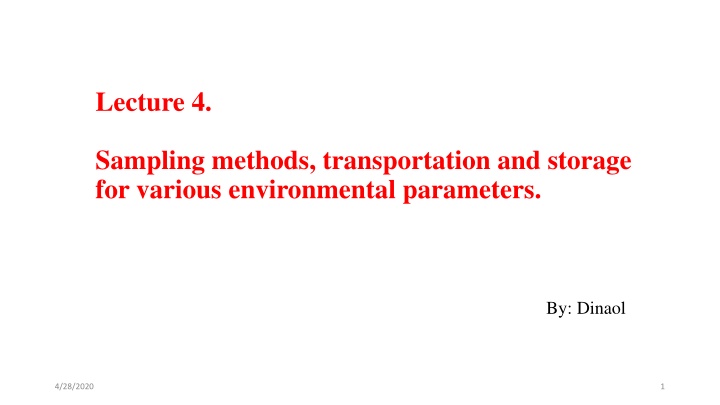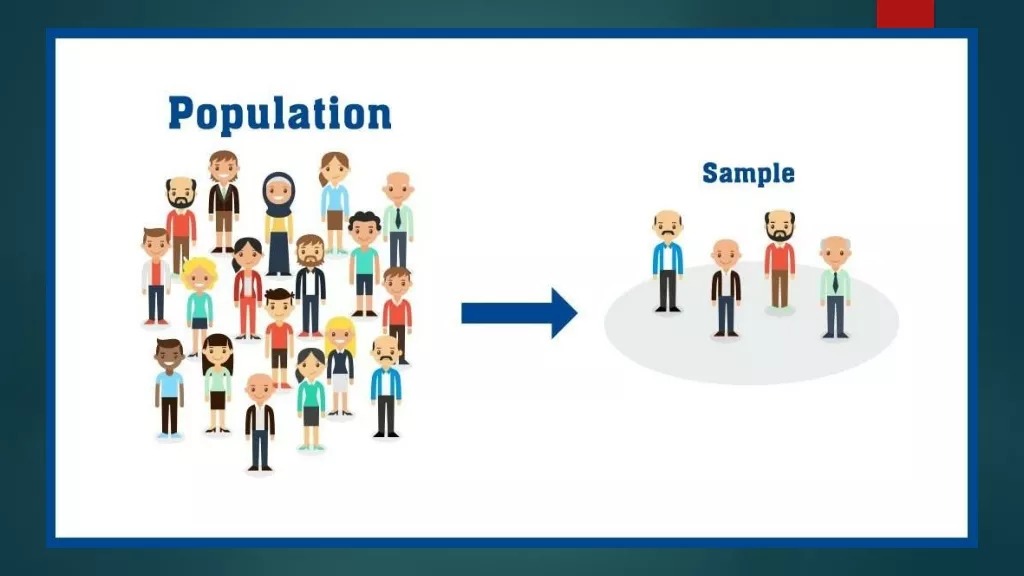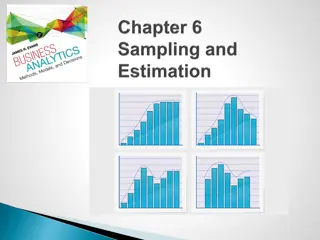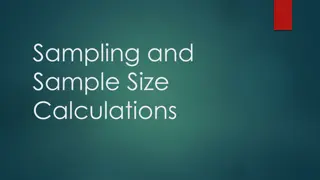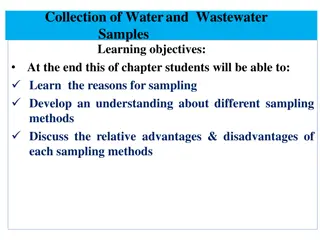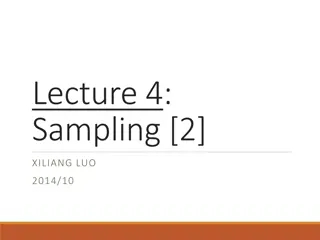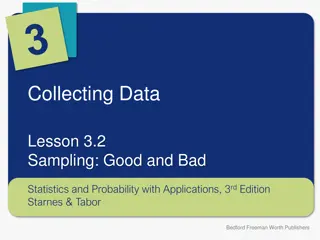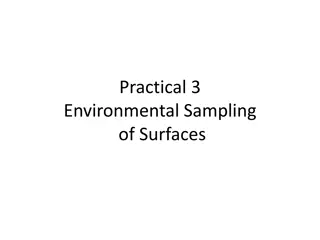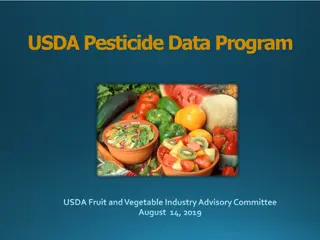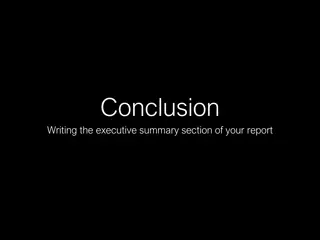Fundamentals of Food Sampling and Analysis
Discover the key methods and procedures for sampling, transportation, and storage of environmental parameters, focusing on food sampling and analysis. Explore the importance of representative samples, quality analysis results, and risks associated with sampling. Learn about homogeneous vs. heterogeneous populations, sampling techniques, and the basics of sample collection. Enhance your understanding of ensuring the quality of laboratory analysis results through proper techniques and practices.
Download Presentation

Please find below an Image/Link to download the presentation.
The content on the website is provided AS IS for your information and personal use only. It may not be sold, licensed, or shared on other websites without obtaining consent from the author.If you encounter any issues during the download, it is possible that the publisher has removed the file from their server.
You are allowed to download the files provided on this website for personal or commercial use, subject to the condition that they are used lawfully. All files are the property of their respective owners.
The content on the website is provided AS IS for your information and personal use only. It may not be sold, licensed, or shared on other websites without obtaining consent from the author.
E N D
Presentation Transcript
Lecture 4. Sampling methods, transportation and storage for various environmental parameters. By: Dinaol 4/28/2020 1
In this Lecture: Food Sampling and analysis 4/28/2020 2
4.1.Food Sampling and analysis 4/28/2020 3
Key Words.. Population the total quantity from which a sample is obtained . Sample a portion, representative whole that of is the 4/28/2020 4
Lot A manufactured or produced under conditions, which are presumed uniform. Sampling Procedure used to draw or constitute a sample. definite quantity of some commodity 4/28/2020 5
Quality of Analysis Results Quality of laboratory analysis results Relays on: 1. Representatives of sample /collection, techniques/ 2. Sample handling /as per the product nature/ 3. Sample transportation 4. Lab Sample preparation 5. Methods 6. Facility /equipment, reagent/ 4/28/2020 6
Is there any risks associated with sampling? 4/28/2020 7
Risks Associated with Sampling There are two types of risks associated with sampling: 1. The consumer risk /probability of accepting a poor quality population/ 2. FBO risk /the probability of rejecting an acceptable product/. 4/28/2020 8
Basics for sample collection Aim of contaminants/ Target population / homo or heterogeneity of population/ sampling /proximate, Microbial, 4/28/2020 9
Sample Collection What is Homogeneous Versus Heterogeneous Populations? 4/28/2020 10
What are sampling techniques? 4/28/2020 11
Sampling Techniques/Methods Basic sampling techniques: Probability sampling, Non-probability sampling, 4/28/2020 12
Types of sampling 4/28/2020 13
Probability Sampling Probability sampling is used when a representative sample is desired, and uses principles of statistical sampling and probability i.e. elimination of human bias. It is a random selection approach that tends to give each unit an equal chance of being selected. 4/28/2020 14
Simple random sampling Number each frame unit from 1 to N. Use a random number table or a random number generator to select n distinct numbers between 1 and N, inclusively. Easier to perform for small populations unpractical for large populations 4/28/2020 15
Systematic sampling Convenient and relatively easy to administer Population elements are an ordered sequence (at least, conceptually). The first sample element is selected randomly from the first k population elements. Thereafter, sample elements are selected at a constant interval, k, from the ordered sequence frame. k = N n Where n = sample size N = population size K= size of selection interval 4/28/2020 16
4/28/2020 17
Stratified sampling involves dividing the population into overlapping subgroups so that each subgroup is as homogenous as possible. Random samples are then taken from each subgroup. The procedure provides a representative sample because no part of the population is excluded and it is less expensive than simple random sampling. 4/28/2020 18
Stratified sampling 4/28/2020 19
Cluster sampling Similar to stratified sampling but the groups are selected for their geographical location dividing the population into clusters or subgroups so that cluster s characteristics are as identical as possible. Any heterogeneity occurs within each cluster. The clusters are sampled randomly and may be either totally inspected or sub sampled for analysis. 4/28/2020 20
4/28/2020 21
Composite sampling is used to obtain samples from bagged products such as flour, seeds, and larger items in bulk. Two or more samples are combined to obtain one sample for analysis that reduces differences between samples. 4/28/2020 22
2. Non-probability Sampling???? 4/28/2020 23
Non-probability sampling Non-probability sampling is used when it is not possible to collect a representative sample, or a representative sample is not desired. The sample collector uses judgement rather than statistical considerations in the selection of the sample. The unusual or unexpected characteristics in a population could be selected to be identified. 4/28/2020 24
Purposive/ Judgment/ Sampling Sampling with a purpose in mind Assessor recruits target population in need. Example: when adulteration is an issue Able to quickly reach targeted sample when sampling for representativeness is not a major concern Usually excludes unique or special cases Often used in rapid assessments 4/28/2020 25
Quota sampling Non-probability equivalent of stratified sampling Assessor identifies stratums and their proportions Convenience or purposive sampling used to recruit samples Select the first sample which aimed to fit the need regardless of what group they represent Key is to select sample which match target population. 4/28/2020 26
Convenience Sampling Draw sample from population that are available and easy to reach This involves selecting the nearest and most convenient people to participate in the research. Used for pilot testing such as a random survey Low cost and quick results May match and compare convenience samples to reduce bias. 4/28/2020 27
Sampling equipment status 4/28/2020 28
Sampling equipment status The devices or equipment's used to collect samples should be sterilized before collecting samples The sampling device should be clean, leak-proof. The devices should have cover/cap The cold food samples should be collected in cold sampling devices 4/28/2020 29
Sampling amount and status 4/28/2020 30
Sampling amount Food sampling technique has it own procedure. The major ones are the following. 1. When taking the sample of packed food, the label should not be damaged. 2. If the amount of the packed food to be sampled is large, the sample should be taken from different places and should be mixed and collected in the sampling devices prepared for this purpose. 4/28/2020 31
Sampling amount 4. The amount of food sample depends on the amount of the source food. 5. If the amount of the food (source food) is less than 5 kg or 5L the whole food can be taken as sample. 6. If the amount of the food is more than 5 kg or 5 Liter the sample to be taken is as follows.. 4/28/2020 32
Table : Minimum Number of Primary Samples to be taken from a Lot Weight/volume of lot (in kg or l) Minimum Number of Primary Samples to be taken from a Lot (kg or l) <50 3 50-500 5 500- 1000 10 1000 - 3000 20 Number of cans, cartons, containers in the lot Minimum Number of Primary Samples to be taken from a Lot (cans or cartons etc) 1-25 1 26-100 5 > 100 10 4/28/2020 33
Sampling Procedure and Minimum Amount to be Sampled from lots of d/t crops Crop Type Sampling Procedure Example Minimum Quantity 5 kg Root, tuber and bulb vegetables Take samples from all areasof the crop. Remove asmuch adhering soil aspossible from samples butdo not wash. Remove as much soil as possible from crops such as celery, but do not wash. Beet ,onions, potatoes, sweet potatoes, turnips Leafy, stem, Fruits and legume vegetables lettuce, spinach, Cucumber, Peppers,tomatoes, Beans, peas (with pods) Maize, wheat 5 kg Cereal Grains Cut not less than ten smallareas (approximately 0.1 m2)chosen randomly from allareas of the crop. Remove grain fromthe straw. 2 kg 4/28/2020 34
Sending the Sample for Analysis 4/28/2020 35
Sending the Sample for Analysis As much as possible do not remove pre-packed retail samples from their packaging. Seal the entire pack in a plastic bag after purchase, and put the sample code on the outside of the bag. Dispatch samples to the laboratory as soon as possible after collection together with type of analysis in need. 4/28/2020 36
